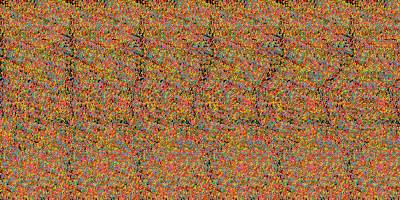How 3D Works - You've GOT to Have Two Separate Images
We can only see the real world in 3D because we have two eyes. If you close one of your eyes, you'll see the world in 2D only.
So what is it that enables us to see in 3D when we have both our eyes open?
Well, because they're a couple of inches apart, each of our eyes gets to see things from a slightly different angle. The small differences between the two views enable our brains to create the sense of distance, or depth, that is essentially what 3D vision is all about. Each individual eye sees just a 2D view of the world, but the brain combines the two views into a single 3D view.
The fundamental requirements for 3D are:
- Two working eyes, each viewing the world from a slightly different perspective (a couple of inches apart).
- A brain that can take the two views and piece them together into one 3D view.
Artificial 3D - recreating the 3D effect artificially
If we look at a standard flat TV screen, we're looking at a flat 2D picture. Because we have 2 eyes we can see the 3D characteristics of the TV box itself (e.g. how thick it is, and how far away from the wall it is, what angle we're looking at it), but there's no depth to the image displayed on the screen - it's just a flat array of pixels showing different colours. It's like looking at a photograph - a 2D snapshot of a place and time.
But it is of course possible for a TV to create the illusion of 3D. I call this "artificial 3D" because there isn't actually a 3D object protruding from the screen - it's still just a 2D array of pixels.
The key to creating an artificial 3D image is in feeding a separate image to each eye. This re-creates the 3D effect that we get when looking at the real world with two eyes. The brain takes the two separate images and combines them into one 3D image.
Of course this doesn't work with any two separate images... The two images must be carefully created and arranged so that they represent what each eye would see if it were looking at a real 3D scene. So, when the brain combines the two separate images (one from each eye), it is tricked into thinking that it actually is looking at a real 3D scene.
Magic Eye pictures or autostereograms

Do you remember the 3D "Magic Eye" pictures (or "autostereograms" that were cool in the 90s? (I'm possibly showing my age here...)
Each Magic Eye picture essentially contained two separate images combined on one sheet of paper. If you crossed your eyes a little, you could get it so that each eye was focusing on a different one of the images. The two images were carefully constructed so that, when your brain combined them into one, it would think it was looking at a real 3D picture.
These Magic Eye pictures can even be animated, as the picture on the right shows.
The trouble is that these Magic Eye pictures aren't really very good. You can't just overlay two detailed photographs onto a sheet of paper and expect each eye to be able to focus on just one of them, not without fancy glasses or other such trickery. So the Magic Eye pictures are limited to using simple repeating patterns that the eyes can separate out into two images. And consequently they're a bit crap.
The basics of 3D filming
To film in 3D requires a 3D camera. And essentially that's just two cameras strapped together, filming two separate images at once. The left camera films the image for the left eye, and the right camera films the image for the right eye.
It's also possible to construct the two images required for 3D computationally. I understand that this was how the 3D version of Clash of the Titans was made (although I also understand the 3D effects in that film weren't particularly great). So I'm not sure that we'll be seeing 3D versions of many films that have already been filmed in 2D (e.g. taking Terminator 2 and making it 3D), but, given the right software, it's definitely pretty straightforward to make 3D versions of computer animated films. When a computer is generating one 3D image already, it's not a great leap to get it to generate a second 3D image from a slightly different angle (for the other eye).
The basics of 3D TV
Just like any other artificial 3D, 3D TV works by feeding a separate image to each eye, so that the brain can unite those two separate images into a 3D picture. The two separate images need to be carefully constructed so that they show the same thing but from slightly different angles, as this is what tricks the brain into combining them into a single 3D image.
The theory of 3D television is very straightforward - one image for each eye. But the technology required to actually implement it with detailed full-colour images is a lot more complicated. Because most people don't want to sit and watch movies that look like the animated Magic Eye picture above :D